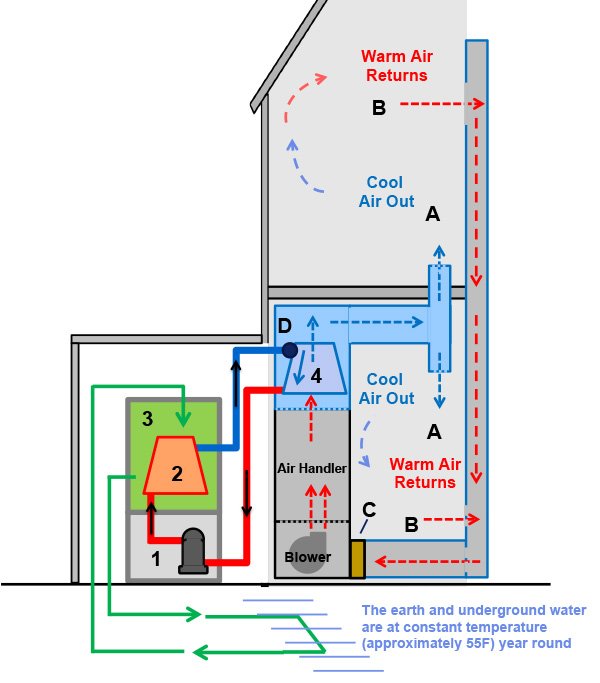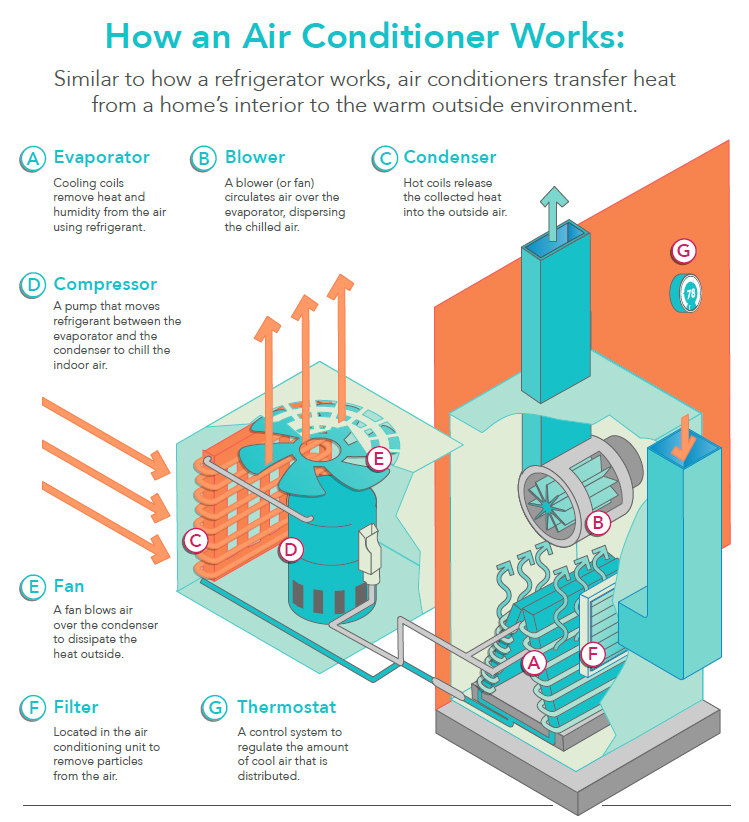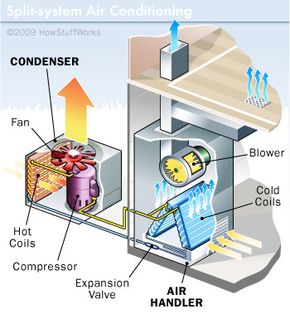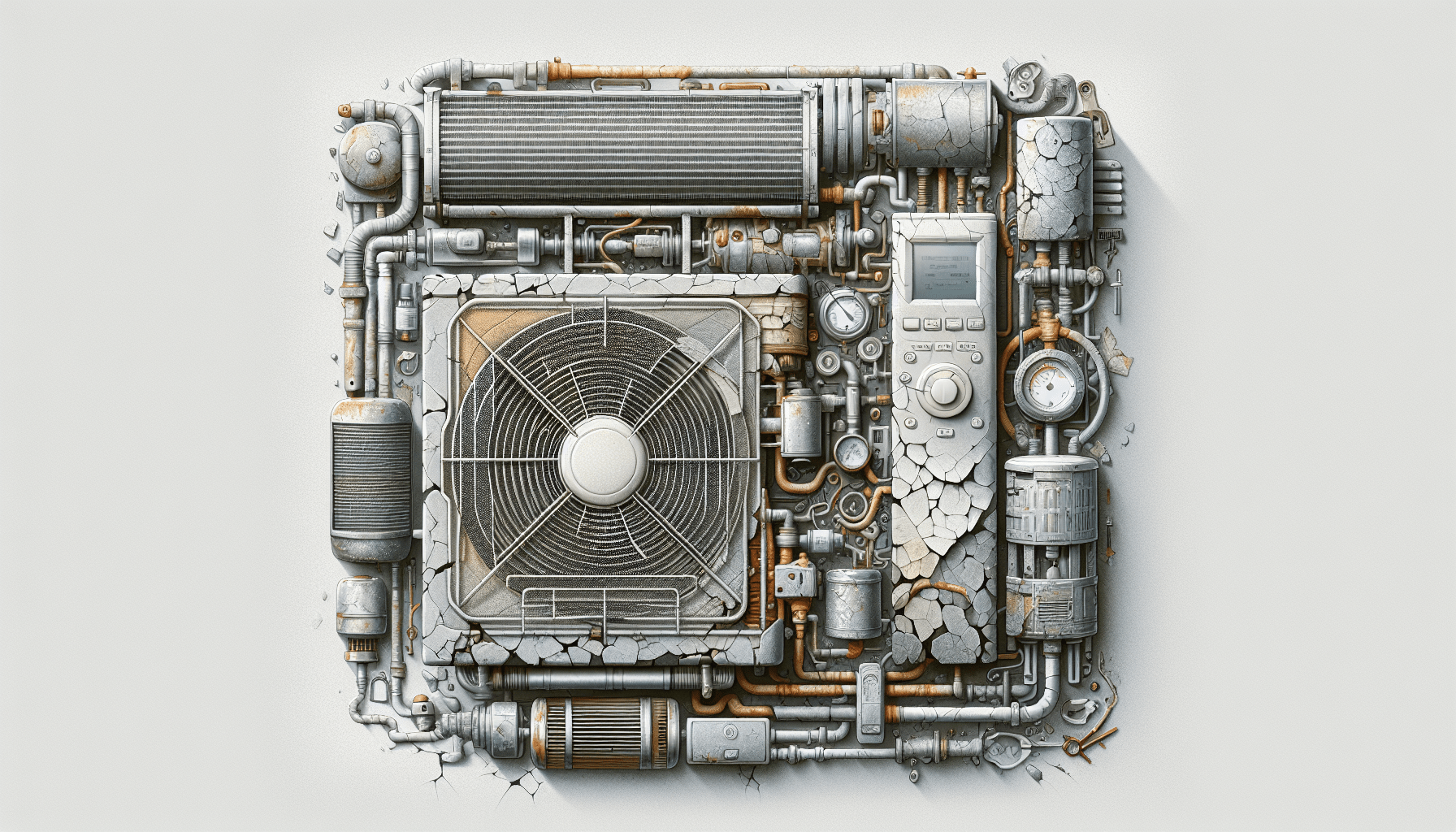Imagine a scorching summer day, and you seek refuge in the cool oasis of your air-conditioned home. As the chilled air embraces you, have you ever wondered how your AC unit manages to create this blissful relief? This article will shed light on the inner workings of an AC unit, unraveling the mysteries behind its ability to transform warm, humid air into a refreshing breeze. From the interplay of refrigerants and compressors to the ingenious science of heat exchange, we will embark on a fascinating journey to understand how an AC unit works its magic to keep us comfortable all summer long.
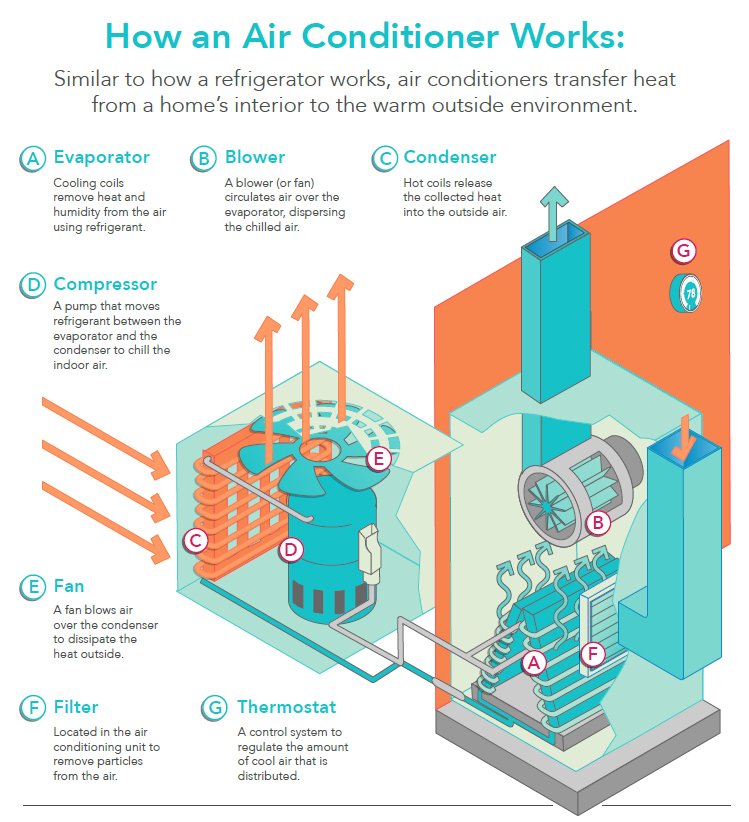
Overview of AC Units
Definition of AC Unit
An AC unit, or air conditioning unit, is a device that is used to cool and dehumidify the air in an enclosed space. It works by extracting heat from the air and transferring it outside, thus creating a comfortable and cool environment indoors.
Importance of AC Units
AC units play a crucial role in maintaining a comfortable indoor environment, especially during hot and humid weather. They not only provide relief from the oppressive heat but also help reduce humidity levels, which can have a negative impact on both comfort and health. AC units are widely used in homes, offices, schools, hospitals, and other commercial and residential buildings to create a pleasant and productive atmosphere for occupants.
Types of AC Units
There are various types of AC units available in the market, each designed to suit different needs and spaces. The most common types include window AC units, split AC systems, central AC systems, portable AC units, and ductless mini-split AC systems. These units differ in terms of size, installation requirements, cooling capacity, and energy efficiency. Choosing the right type of AC unit depends on factors such as the size of the space, budget, and specific cooling requirements.
Basic Components of an AC Unit
Compressor
The compressor is the heart of an AC unit and is responsible for circulating refrigerant throughout the system. It compresses the low-pressure refrigerant gas, raising its temperature and pressure before sending it to the condenser coil. The compressor plays a vital role in the cooling process and influences the overall efficiency and performance of the AC unit.
Condenser Coil
The condenser coil is located in the outdoor unit of the AC system and is responsible for releasing heat from the refrigerant into the surrounding air. As the high-pressure, high-temperature refrigerant gas flows through the condenser coil, it cools down and turns into a high-pressure liquid. The condenser coil works in conjunction with the compressor to expel heat from the indoor space.
Expansion Valve
The expansion valve, also known as the metering device, is a small component located between the evaporator coil and the condenser coil. It controls the flow of refrigerant and regulates its pressure, allowing it to expand and evaporate in the evaporator coil. By reducing the pressure of the refrigerant, the expansion valve facilitates the cooling process and ensures optimal performance of the AC unit.
Evaporator Coil
The evaporator coil is located in the indoor unit of the AC system and is responsible for absorbing heat and moisture from the air. When the refrigerant passes through the evaporator coil, it absorbs heat from the indoor air, causing the refrigerant to evaporate and turn into a low-pressure gas. This cool air is then circulated back into the room, while the warm air and moisture are expelled through the exhaust system.
Refrigerant
Refrigerant is a chemical compound used in AC units to facilitate the cooling process. It undergoes phase changes from a gas to a liquid and vice versa, absorbing and releasing heat in the process. The most commonly used refrigerants in AC units are hydrofluorocarbons (HFCs), such as R-410A and R-134a, which are known for their low environmental impact and non-flammable properties.
Fan
A fan is an essential component of the AC unit as it helps circulate air and improve airflow. There are two main fans in an AC unit: the condenser fan, located in the outdoor unit, and the evaporator fan, located in the indoor unit. The condenser fan helps dissipate heat from the condenser coil, while the evaporator fan blows air across the evaporator coil to cool it down and circulate the cooled air into the room.
Key Processes in an AC Unit
Compression Process
The compression process starts with the compressor taking in low-pressure refrigerant gas from the evaporator coil. The compressor then compresses the gas, increasing its pressure and temperature. This compressed gas is then sent to the condenser coil to release heat.
Condensation Process
In the condensation process, the high-pressure refrigerant gas enters the condenser coil, which is surrounded by the outdoor air. As the refrigerant flows through the coil, it dissipates heat into the outdoor air, causing it to cool and condense into a high-pressure liquid.
Expansion Process
After the condensation process, the high-pressure liquid refrigerant enters the expansion valve. The expansion valve regulates the flow and reduces the pressure of the refrigerant, allowing it to expand and cool down as it enters the evaporator coil.
Evaporation Process
In the evaporator coil, the low-pressure refrigerant expands and evaporates, absorbing heat and moisture from the indoor air. The cool air produced by this evaporation process is then circulated back into the room while the warm air and moisture are expelled through the exhaust system, creating a comfortable indoor environment.
Cycle of Operation
Step 1: Cooling Mode
When the AC unit is turned on, it enters the cooling mode. The compressor starts circulating the refrigerant throughout the system, and the fan in the indoor unit begins blowing warm air over the evaporator coil.
Step 2: Removing Heat
As warm air passes over the evaporator coil, the refrigerant absorbs heat from the air, causing it to evaporate and turn into a low-pressure gas. This heat absorption process results in the cool air being circulated back into the room.
Step 3: Circulating Cool Air
Meanwhile, the condenser fan in the outdoor unit starts running, and the high-pressure refrigerant gas enters the condenser coil. The condenser coil releases heat into the outdoor air, allowing the refrigerant to cool down and condense into a high-pressure liquid.
Step 4: Adjusting Temperature
The expansion valve controls the flow of the refrigerant, ensuring that the right amount enters the evaporator coil. This regulation helps maintain a consistent temperature and ensures optimal cooling efficiency.
Step 5: Shutting Down
Once the desired temperature is reached, the AC unit cycles off, temporarily halting the cooling process. When the temperature rises again, the cycle restarts, and the AC unit resumes its cooling operation.
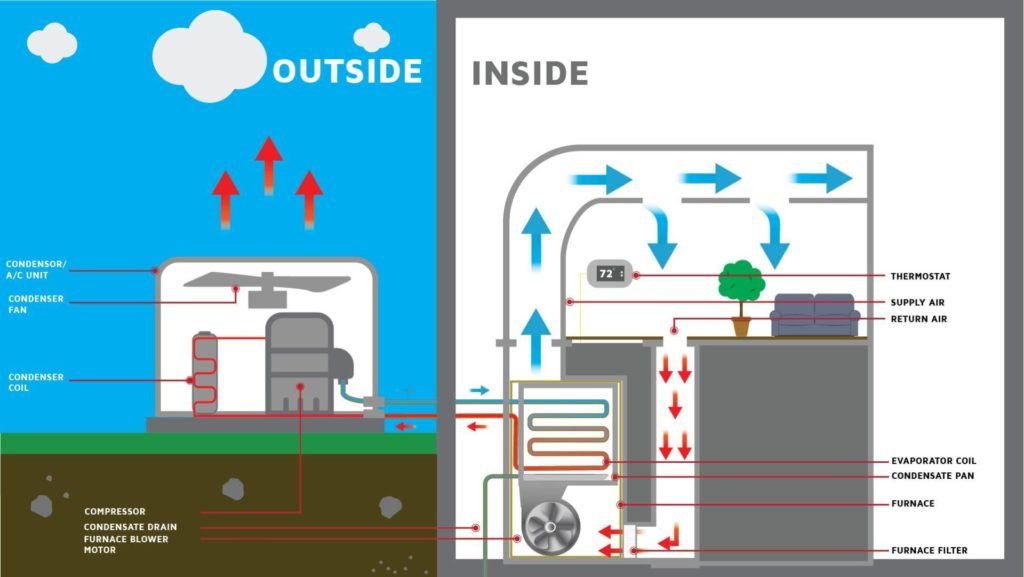
Detailed Explanation of AC Processes
1. Compression Process
The compression process plays a crucial role in raising the temperature and pressure of the refrigerant gas. The compressor uses a piston or rotary mechanism to compress the gas, effectively trapping its molecules and compressing them close together. This compression increases the energy and temperature of the gas, preparing it for the next phase of the cooling process.
2. Condensation Process
In the condensation process, the high-pressure refrigerant gas flows into the condenser coil, surrounded by the outdoor air. The condenser coil is designed to maximize the surface area available for heat exchange. As the refrigerant gives up its heat to the outdoor air, it cools down and condenses into a high-pressure liquid.
3. Expansion Process
After the condensation process, the high-pressure liquid refrigerant enters the expansion valve. The expansion valve acts as a regulator, controlling the flow and reducing the pressure of the refrigerant. By creating a pressure drop, the expansion valve allows the refrigerant to expand rapidly and cool down as it enters the evaporator coil.
4. Evaporation Process
In the evaporator coil, the low-pressure refrigerant expands and evaporates, absorbing heat and moisture from the indoor air. The evaporator coil, equipped with numerous fins to maximize surface area, allows for efficient heat exchange between the refrigerant and the air. As the heat is absorbed, the refrigerant turns into a low-pressure gas, cooling the air around it. The cooled air is then circulated back into the room via the fan, while the warm air and moisture are expelled through the exhaust system.
Key Role of the Refrigerant
Definition of Refrigerant
A refrigerant is a chemical compound used in AC units to facilitate the cooling process. It undergoes phase changes from a gas to a liquid and vice versa, absorbing and releasing heat in the process. Refrigerants are specifically engineered to have low boiling points, allowing them to readily change from a liquid to a gas and back again under varying pressure conditions.
Properties of an Ideal Refrigerant
An ideal refrigerant should possess several properties, including high efficiency, non-toxicity, non-flammability, stability, and low environmental impact. It should be able to absorb and release heat efficiently, without causing any harm to humans or the environment. The development of more environmentally friendly refrigerants is an ongoing effort in the HVAC industry.
Common Types of Refrigerants
Hydrofluorocarbons (HFCs) are the most common types of refrigerants used in AC units today. R-410A is one of the popular HFC refrigerants, known for its high efficiency and environmental friendliness. Other common refrigerants include R-134a, used in automotive air conditioning systems, and R-22, which is being phased out due to its contribution to ozone depletion.
Refrigerant Flow in an AC Unit
The refrigerant flows in a closed-loop system within the AC unit. It starts by entering the compressor as a low-pressure gas and is compressed, raising its temperature and pressure. The high-pressure refrigerant then flows to the condenser coil where it releases heat and condenses into a high-pressure liquid. The liquid refrigerant then enters the expansion valve, where its pressure and flow rate are regulated. After passing through the expansion valve, the refrigerant enters the evaporator coil where it evaporates and absorbs heat. The low-pressure gas refrigerant then returns to the compressor to complete the cycle.
Importance of the Compressor
Function of the Compressor
The compressor is often referred to as the “heart” of an AC unit because it performs the vital task of circulating refrigerant throughout the system. Its main function is to compress the low-pressure refrigerant gas to a higher pressure and temperature, allowing it to release heat more efficiently in the condenser coil. The compressor is a key component that determines the overall performance and cooling capacity of the AC unit.
Types of Compressors
There are several types of compressors used in AC units, including reciprocating compressors, rotary compressors, screw compressors, and scroll compressors. Each type has its own advantages and characteristics, with factors such as efficiency, noise level, and installation requirements varying between compressors. The choice of compressor type depends on the size and cooling requirements of the space, as well as factors such as cost and availability.
Compressor Location
In most AC units, the compressor is located in the outdoor unit, along with the condenser coil and the fan. Placing the compressor outside helps minimize noise inside the building and provides easy access for maintenance and repairs. Some AC units, particularly split systems, may have a separate indoor unit with a smaller compressor, known as a mini-compressor or an inverter compressor.
Maintenance Tips for the Compressor
Proper maintenance of the compressor is essential to ensure its continued performance and longevity. Regular inspections, cleaning, and lubrication can help prevent compressor issues and improve its efficiency. It is important to keep the compressor and its surrounding area clean from dirt, debris, and vegetation. Additionally, keeping the refrigerant levels within the manufacturer’s recommended range and scheduling professional maintenance can help identify and address any potential compressor problems before they escalate.
Condenser and Evaporator Coils
Condenser Coil
The condenser coil, located in the outdoor unit of the AC system, is responsible for dissipating heat from the refrigerant into the outdoor air. It consists of a series of copper or aluminum tubes with fins attached to increase the surface area for heat exchange. As the high-pressure refrigerant gas flows through the condenser coil, it cools down and condenses into a high-pressure liquid, releasing heat in the process.
Evaporator Coil
The evaporator coil is located in the indoor unit of the AC system and is responsible for absorbing heat and moisture from the indoor air. It works in conjunction with the compressor and expansion valve to facilitate the cooling process. The evaporator coil consists of a network of tubes with fins, similar to the condenser coil, to maximize heat exchange. As the low-pressure refrigerant passes through the evaporator coil, it evaporates and absorbs heat from the indoor air, cooling it down.
Heat Exchange between Coils
The heat exchange between the condenser and evaporator coils is a crucial aspect of the cooling process in an AC unit. The condenser coil releases heat into the outdoor air, while the evaporator coil absorbs heat from the indoor air. This heat exchange not only cools down the indoor space but also helps dehumidify the air by condensing moisture from the warm indoor air onto the evaporator coil.
Cleaning and Maintenance
Regular cleaning and maintenance of the condenser and evaporator coils are essential to ensure optimal performance and energy efficiency. Over time, these coils can accumulate dirt, dust, and debris, which can impede heat exchange and reduce efficiency. Cleaning the coils periodically can improve airflow, prevent clogs, and prolong the lifespan of the AC unit. It is recommended to hire a professional or follow the manufacturer’s instructions for proper cleaning and maintenance procedures.
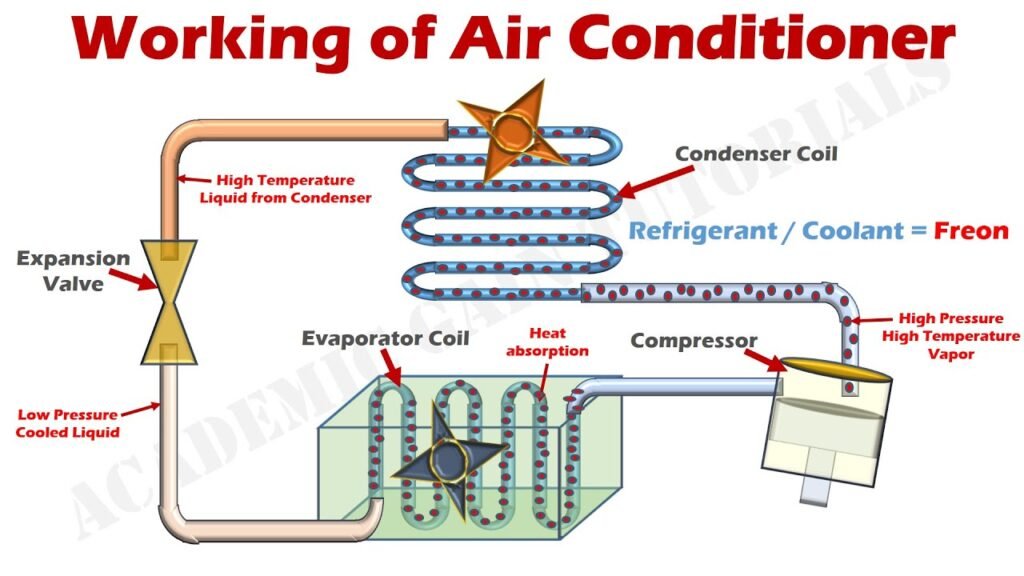
Role of the Expansion Valve
Definition and Function
The expansion valve, also known as the metering device, is a small component located between the evaporator coil and the condenser coil. Its main function is to regulate the flow and reduce the pressure of the refrigerant as it enters the evaporator coil. By creating a pressure drop, the expansion valve allows the refrigerant to expand rapidly, facilitating the cooling process.
Types of Expansion Valves
There are several types of expansion valves used in AC units, including fixed orifice expansion valves, thermal expansion valves (TXVs), and electronic expansion valves. Fixed orifice expansion valves have a fixed opening size and allow a constant flow of refrigerant into the evaporator coil. TXVs, on the other hand, use temperature and pressure sensing mechanisms to adjust the flow of refrigerant based on the cooling demands. Electronic expansion valves provide precise control over the refrigerant flow and are often used in advanced HVAC systems.
Significance in Cooling Process
The expansion valve plays a crucial role in the cooling process by regulating the flow and pressure of the refrigerant. It ensures that the right amount of refrigerant enters the evaporator coil, optimizing the cooling efficiency and maintaining a consistent temperature. The expansion valve also helps prevent flooding of the evaporator coil, which can affect the performance and cooling capacity of the AC unit.
Maintenance and Troubleshooting
Maintaining the proper operation of the expansion valve is essential for optimal cooling performance. Periodic inspections and adjustments can help prevent issues such as clogging, frost formation, and excessive refrigerant flow. If the expansion valve is not functioning correctly, it can lead to inefficient cooling, inadequate dehumidification, or even damage to the AC unit. In case of any issues, it is recommended to consult a professional HVAC technician for maintenance and troubleshooting.
Energy Efficiency and AC Units
SEER Rating
The Seasonal Energy Efficiency Ratio (SEER) is a measure of an AC unit’s energy efficiency. It quantifies the ratio of cooling output to electrical input over an entire cooling season. The higher the SEER rating, the more efficient the AC unit is in converting electrical energy into cooling output. In the United States, the minimum SEER rating for new residential central AC units is 14, while more efficient units can have SEER ratings of 20 or higher.
Factors Affecting Energy Efficiency
Several factors can affect the energy efficiency of an AC unit. Proper sizing and installation are important to ensure that the unit matches the cooling requirements of the space. Insulation levels, ductwork design, and air leakage also impact efficiency. Regular maintenance, including cleaning filters and coils, can help optimize performance. Additionally, factors such as climate, usage patterns, and thermostat settings influence the energy consumption of the AC unit.
Tips for Improving Efficiency
To improve energy efficiency and reduce cooling costs, consider the following tips:
- Ensure proper insulation in the building to minimize heat gain.
- Seal air leaks in windows, doors, and ductwork to prevent cool air from escaping.
- Keep the AC unit and its surrounding area clean from debris and obstructions.
- Set the thermostat at an appropriate temperature and consider using programmable thermostats for more efficient temperature control.
- Use ceiling fans or portable fans to improve airflow and circulate cool air.
- Schedule regular maintenance and tune-ups to keep the AC unit running efficiently.
- Consider upgrading to a more energy-efficient AC unit with a higher SEER rating.
Energy-Efficient Alternatives
In addition to traditional AC units, there are energy-efficient alternatives available for cooling, such as evaporative coolers, also known as swamp coolers, and heat pumps. Evaporative coolers use water evaporation to cool the air and are particularly effective in dry climates. Heat pumps, on the other hand, are capable of both cooling and heating spaces, making them versatile and energy-efficient options.
In conclusion, AC units are essential for creating a comfortable indoor environment, especially during hot and humid weather. They rely on basic components like the compressor, condenser coil, expansion valve, evaporator coil, refrigerant, and fan to perform key processes such as compression, condensation, expansion, and evaporation. The compressor, condenser and evaporator coils, and expansion valve play crucial roles in the cooling process. The refrigerant is responsible for absorbing and releasing heat, while energy efficiency is determined by factors like the SEER rating and proper maintenance. By understanding the fundamentals of AC units, homeowners and building occupants can make informed decisions about their cooling needs and improve their overall comfort and energy efficiency.
